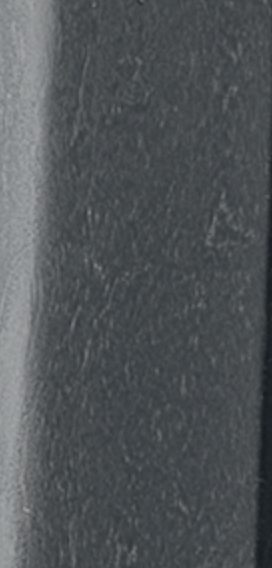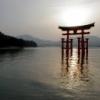Leaderboard
Popular Content
Showing content with the highest reputation on 06/23/2025 in all areas
-
Well, another show has come and gone, and planning has already started for the next one in 2026. The show was a huge success thanks to Mark Ceskavich, Susan Ceskavich, Ray Singer, Joe Forcine and a cast of others who planned, executed, curated and lectured throughout the weekend. Special thanks to Markus Sesko for his presentation on Yamashiro blades which included a bevy of beauties from the early Kamakura through the Muromachi. Highlights included an Awataguchi, a Shintogo Kunimitsu, a Rai Kunimitsu, a Rai Tomokuni, an Enju, a Nobukuni and a Hasebe Kunishige. Tsuba show and tell and mei verification with Markus were also really popular. Sales were decent and deals were had. We look forward to seeing everybody in San Francisco and preparing for the show next year. We have some really cool ideas. Watch this space. Best, Bobby5 points
-
Hello, The kasane per se does not inform you on the state of the sword. The delta between the top of the nakago and the kasane is the indicator you need to pay attention to. There are smith-level trends, school-level trends, and most important: era-level trends on the thickness of the kasane. The most well-known is the transition between Kamakura and Nambokucho, where Nambokucho swords have - on average - a much thinner kasane. As for the structural aspect, remember that it interacts with the thickness and level of the shinogi, the niku, and the width of the motohaba/sakihaba. Controlling for these factors, a thicker kasane indicates a sturdier sword, all else equal, but it is first and foremost a balance of different geometrical elements. Also take note that skilled smiths created a balanced descending gradient between the motokasane and the sakikasane which is one of the most important contributor to the feeling of balance. This descending gradient is generally not uniform - the gradient tapering accelerates towards the tip. This type of geometry is often followed by Soshu-Joko smith (Masamune, Norishige, Yukimitsu, Go, Sadamune), leading to an impressive feeling of balance on a robust and masculine sugata, and this generally drives the contrast with shinto/shinshinto smiths, whose blade tend to feel 'tip heavy'. Koto blades with a thick motokasane (7.5mm+) are considered a plus and can contribute to passing Juyo, and this is generally a strong point. 5.5-7.5mm: normal kasane below 5.5mm : thin kasane Above 7.5: thick kasane Best, Hoshi3 points
-
関住川崎兼泉作 = Seki-jū Kawasaki Kanezumi saku Not a lot of information about this smith apart from an old thread here:3 points
-
A big pro of shinshinto IMHO is you can get healthy, nice polish nearly flawless blades in old shapes for a low price. It's where I think a lot of newcomers on a budget should start out. The con is usually not so impressive activities in the steel and 'lack of historical relevance', the latter you can get around by focusing on smiths of note or those making weapons intended for use, eg Aizu smiths during the Boshin war. Some of the most beautiful swords and fittings ever made were produced during this period.3 points
-
You can own a sword that is pretty much the size and shape the smith intended rather than what is left after age and use. Obviously age and the patina of use have their charm too, but I think there are fewer trade-offs with younger blades.3 points
-
3 points
-
Similar designs. http://www.nihonto.us/KIRI TOSOGU SET.htm These top two look like a before and after clean.3 points
-
I'm proud to announce that my Kirishitan tsuba got awarded the 4th Effort Award in this year's NBTHK contest! This is an incredible reward for my hard work on improving my skills. To my knowledge i'm the only foreigner to win an award in this category for NBTHK competitions ( Ford Hallam only achieved Nyusen before moving to NBSK). My work will be featured in the catalogue and the exhibition, so please take a look if you have the chance. Following there are the pictures and a link to a video that shows the special feature of the mimi Link to the video https://drive.google.com/file/d/15HyBoEufhpyEx98n4Y9BETWOtrMtt5o6/view?usp=drive_link2 points
-
Yes Piers, indeed I overlooked it, or I didn't identify it as a crack. If Paris has the TSUBA in his hands, he might confirm. On the other hand, looking at the second TSUBA image, the TAGANE strokes have a certain resemblance in my eyes, so I would not exclude the possibility of them being a personal mark.2 points
-
Do you know who the consignment seller is, or is it just being sold by an anonymous person on the internet? The one small tidbit I can provide is that the sword was registered in Ehime prefecture, and the Kamata family was indeed from Ehime. The Vice Admiral's son (Kamata Hideo) was an accountant who died in 2009, and the accountant's son (Kamata Toshiya) is a music producer based in Tokyo. He's got his own twitter and instagram page.2 points
-
Marcin, Yes it’s real. These are post-war souvenir swords produced for the U.S. occupation forces. These swords were assembled with a mix of Kai Gunto and Shin Gunto fittings. See the below thread for the bulk of the discussion.2 points
-
Hello, I like Shinshinto for bizen or Soden-bizen utsushi in perfect condition and often absolutely beautiful horimono, in my opinion horimono were the best at shinshinto... Best, Eric2 points
-
Hopefully your family had a wonderful trip to Japan. 🤗 I do think the sword you bought was a nice one. Prices in yen have gone up so making comparisons to old prices even from few years ago is difficult. Also Echizen Rai / Chiyozuru / Chiyozuru Morihiro, etc. for me personally the attributions wont matter too much. I could be mistaken for the koshirae too so my word is not granted as I dont at the moment have access to the old sale page and info. However as you said there are multiple really nice components. I personally really like rayskin saya and this one has an interesting one. Leather tsukamaki is also something I am liking a a lot. I believe for your sword the koshirae parts are actually most likely Edo period parts that have been put together. Hopefully you will enjoy the sword for a long time and you have the happy memory of purchasing the sword on your family trip.2 points
-
Dear Brian. Hard to see from these pictures but I think you are right. Bear in mind that tsuba are often made by folding and fire welding steel so that sometimes a weld line is visible in the nakago ana or ryo hitsu, the distinguishing characteristic is that seam lines caused by casting are raised from the surface, weld lines tend to dip into the surface. All the best.2 points
-
Hello everyone, I recently bought a decent navy Kyu gunto on Jauce and the description seemed more like a creative writing exercise than anything else! I bid for the quality of the sword and koshiere not The story as many of us learn early on. The package itself is decent as you can see by these pictures. Now for the fun part, in short, the description states that sword belonged to vice Admiral Michiaki Kamada. I am wondering if anyone can contact the seller on my behalf to try get any further evidence of their claim. Jauce has refused to do so. The whole description as well as a link to the auction page is found below: Imperial Japanese Navy Officer's Long Sword, Two-handed Gunto (Early Model), Command Sword, Military Sword, Ceremonial Sword, Short Sword, Shark-polished Scabbard, Different Hawk Feather Family Crest, Regular Sword Cord Included. We are consigning and selling on behalf of the customer. Background: A relic with a complex history and story - a two-handed Navy Meiji 19th Type Gunto owned by Vice Admiral Kamada Michiaki of the Imperial Navy. It is not just a sword, but a symbol of an era and a testament to having witnessed a series of history. Vice Admiral Kamada Michiaki was an officer of the Imperial Navy and a hero who achieved military success, leaving a deep mark on the history of World War II. This item is a single sword of the Meiji 19th Type, standard for naval officers, handed down to the Kamada family of Ehime Prefecture, and the Kamada family crest is inlaid in gold on the handle. The blade is a famous sword passed down through the family, and its details are as follows: ●Blade This is an anonymous sword with an old sharpening, and the blade pattern is a medium straight blade with some irregularities, giving it the feel of an old sword. The surface is a forged texture with a mixture of grain and wood grain, and although there are scratches, rust marks, and scuffs, there are no sharp edges or bulges. The blade was registered as a daimyo in 1957. The above is merely my personal (amateur) opinion, so please look closely at the photos and make your own responsible bid. ・Blade length 2 shaku 2 sun 9 bu 0 rin (69.4 cm) Curvature 3 bu 5 rin (1.06 cm) 4 eyelets (2 filled) ・Butt width 2.9 cm (amateur measurement) ・Butt weight 0.6 cm (amateur measurement) ・Tip width 1.9 cm (amateur measurement) ・Tip weight 0.5 cm (amateur measurement) ●Mounting (Imperial Japanese Navy Officer's Long Sword, Two-handed grip (early model)) Black polished shark leather wrapped sheath, no cracks or chips, in good condition. Considering the age, there is little damage to the plating of the metal fittings, etc., and I think it is in relatively good condition. In addition, the carp mouth (outer diameter) is large at 4 cm, and overall it is impressive, and seems to be a custom-made product. The handle is made of large, uniform shark leather, and although the gold wire and metal fittings show dirt and rust marks from the age, there are no defects, and I think it will look good with some polishing. The above is only my personal opinion (amateur), please look at the photos carefully and make your own responsible decision before bidding. ・Total length 96.4 cm (amateur measurement) ・Handle length 21.3 cm (amateur measurement) ・Koiguchi (outer diameter) 4.0 cm length x 2.3 cm width (amateur measurement) ・Habaki (silver-plated Yujo) This sword has survived all kinds of wars along with General Kamada's military career, and has imprinted the era full of hardship. It has been drawn on the battlefield many times, leaving many scars as evidence of fierce battles. Now it stands quietly, as if speaking of the sorrows and joys of those passionate days. Every time I pick up the sword, the big waves of the Pacific Ocean and the heroic figure of the hero come to mind, and this sword will play a role in conveying the heroic spirits of the country to the present. It was discovered when the family was sorting out the belongings of the deceased, and this sword is being sold by a consignment agent https://buyee.jp/item/jdirectitems/auction/v1189243888/detail Thanks everyone, I hope you enjoy the story as much as I have, and I can't wait to think of the big waves of the Pacific ocean when I finally get this in hand. 😂1 point
-
This is insanely good work. Well done, the piece exalts power and faith.1 point
-
Link in that thread is dead. Good example of why I wish guys would post actual photos rather than using links.1 point
-
On my Mac I have Safari, Chrome and Firefox and use them all. My older 2012 Macbook Pro is beginning to hit issues, especially with Safari, so its useful to have the other browsers, with Firefox being the most useful as it appears to receive many more updates compared to Safari.1 point
-
I suppose that's true, but everything tracks--Samurai mon on the fuchi, early mounts from approx. 1936 since it's a Type 94, a family blade. Things like that.1 point
-
1 point
-
Good very old school multi generational shop. 4th gen now? Several of you are giving very good advice. So far, I agree. Nagoya >> Kyoto > Tokyo More shops in Tokyo here and there, but you sort of get that greasy used car lot feel from Aoi Arts. They are not as they were 20-30 years ago. Some of the very very best, and a lot of the worst, are located in Tokyo. @MEENag good luck. Though it may be confusing, the others are trying to help. It is a shame there isn't a strong central organized club in Texas these day. Things shift, so you will have to rely on internet groups a bit more.1 point
-
1 point
-
Paris, looks a bit as if someone tried his screwdriver on that TSUBA. These are not KANJI, so no MEI.1 point
-
Please note the cast replica Water-wheel and bridge in the lower right of image - part of a tourist quality display board. https://www.jauce.com/auction/q1189828556 or https://buyee.jp/item/jdirectitems/auction/q11898285561 point
-
You would think, weirdly enough the blade does not look that tired. Boshi is relatively healthy, pic related. Part of me is curious if it was just measured incorrectly, since I am aware this definitely happens. My kanenobu was advertised as an 8mm motokasane, however upon measuring it its more around 9mm.1 point
-
5-7mm is average, and strength at the motokasane is very important due to the concentration of stress right at that point when the sword meets resistance or some kind of impact, just above where the hands hold the tsuka. That said, swords were generally designed for a purpose, for example armored combat (much more kinetic) vs unarmored combat (more of a slicing action needed), so you’ll see variations. An engineer could certainly explain this better than I can though!1 point
-
Truthfully, I'm not exactly sure what to classify this activity as, maybe an utsuri??? Almost certainly it will have a name, be categorized. Shirake utsuri, hmm. Shirake utsuri when seen is white, not like this. Muneyaki, no. Muneyaki first of all runs along and or borders the mune, not below the shinogi. There are two forms of muneyaki seen. One is more like a tobiyaki (considered inferior). The other is more like a yubashiri (superior). https://markussesko.com/2015/05/14/kantei-2-jigane-jihada-3/ https://markussesko.com/2015/05/29/kantei-3-hamon-boshi-1/1 point
-
With Shinshinto, you do need to be a bit selective as there were a lot of not so artistic smiths just making blades to get by. However, you can run across beauties like this: Obviously, the smiths who had the time and wherewithal to imitate, study, and expand upon their Koto masters were the best: Kiyomitsu, Sadakazu, Kanesada to name a few. I'd argue that the relative recentness of these works makes it more relevant to study them while the items and the history is still easier to preserve. Given time, all things wither and disappear under the sands.1 point
-
1 point
-
1 point
-
I will stay away from answering that question - but if you enjoy a day reading then see this thread - https://www.militaria.co.za/nmb/topic/38416-tsuba-casting-molds/ Let's just say these cast pieces do turn up from collections at the beginning of the 20th century and that they are "antiques". But we think they were rarely used on swords other than tourist pieces or swapped over onto older blades. Your other guard I can't be sure of a school or date, but looks genuine to me. There is a solitary Kiri flower amongst the tendrils/branches [paulownia tree?] 1 o'clock position. Piers beat me to it.1 point
-
Hi, i am not an expert, i am on the beginning, for me the fascinate part of Shinshinto, is the Fukkoto movement. You have a big diversity of blades across from all styles and the Sugata isn't so uniform like in Shinto. Price is also a factor, good healthy Koto blades are more expensive. My main resource is Shinshinto-shi from Markus Sesko. regards Oli1 point
-
Just a few reasons why this might be the case: Wakizashi in general are less popular than daito or tanto Papers are often out of date even when legit (a Tametsugu Hozon blade may have gotten downgraded to TH Ko-Uda, so the seller conveniently "lost" those papers and sold it as Tametsugu) Condition issues (tired, hagire, ware) that aren't listed ("please check the photos for the condition of the sword") From the above two items, a blade might be unlikely to go any higher than the papers it already has Relatives of a deceased collector consigning items to be sold as quick as possible to sort out financial issues And in general, eBay is much harder to sell nihonto on now unless you're a reputable seller, because the market is flooded with so many fakes, scams, Chinese shinken etc - far more so than it used to be 10, 20 years ago.1 point
-
Shirasaya originated in the mid-Edo period when the Honami family of appraisers were employed to evaluate, authenticate and index the sword collections of important families. These families had many swords in almost permanent storage and so shirasaya were regarded much like the magnolia boxes used to protect valued tea utensils such as bowls and teaspoons. As with these other wooden containers, the Honami would write formal descriptive calligraphy onto the plain white wood. Then, following the Meiji Restoration, and the subsequent abolition of wearing swords in 1876, shirasaya became a necessity.1 point
-
Thank you for sharing this. I came across one myself and have been doing research on the winter camo. Unfortunately information is scarce. As Bruce said, the color is not even listed on Ohmura's website. I have also found examples of helmets and bayonets painted white. From what I understand, they could have seen use in Manchuria or the Aleutian islands. The tsukaito is missing on my example, but there is white paint on the rayskin where it would have been exposed under the wrap, suggesting it was painted white. Sadly the old blade is in bad condition.1 point
-
Interesting finds - well interesting prices https://www.amazon.com/dp/B0BXQ2P8WZ?tag=picclick0f-20&linkCode=osi&th=1&psc=1 A hard cover copy from Amazon Prime for less than the postage for me of my own book! $16. 90 for 408 pages https://www.amazon.com/dp/B0D86MSQK5?tag=picclick0f-20&linkCode=osi&th=1&psc=1 a soft cover book - likewise cheaper than postage - but they won't ship to Australia! $18.27 for 324 pages I don't care about any "royalties" but someone should grab these two books just to confound the seller who can't actually get the books printed at those prices! Check out the book prices here : https://picclick.com/Popular/tsuba-book This one in Japanese [not one of mine] is also a bargain compared to its normal selling price https://www.ebay.com/itm/4051954716171 point
-
Ahh, so I was standing behind you when you were taking those photos. You were equally smitten by the Sa Kunihiro. The whole package was perfect. Tanobe sayagaki, recent Juyo papers, superior/elegant antique koshirae, solid gold habaki. Your photos truly show the beauty of the blade.1 point
-
1 point
-
1 point
-
1 point
-
1 point
-
1 point
-
1 point
-
I bought an item from Touken Takarado at Japan Art Fair. I wanted to share my great experience. They were as friendly as professional. Their inventory was very interesting with a wide proposition from koto to very young blades, always qualitative. Highly recommended!1 point
-
I wouldn't get too caught up in smith names or time periods. Go to a reputable dealer and buy what you like, what calls to you, because you'll be living with it and appreciating it for a long time. I have swords from 1200s, 1300s, 1400s, 1500s, 1600s and 1800s and my favorite is one from the 1600s. Hits me every time I draw it from the Shirasaya.1 point
-
One word of warning. There is no perfect blade, as everyone knows. You seem to be asking for people to point out stuff you cannot see, in advance. But if someone actually does that, you then seem to go off the boil, as with your first candidate above and BBB's subsequent comments. If you show a blade to people, ten people will tell you ten different things. If the blade is really good, and cheap at the price, someone may step in and buy it! In order to rise above small defects, you may decide to spend more and more, until you reach another fiscal limit, only to have another flaw or drawback pointed out by some higher authority later. Some collectors have several swords, each with imperfections of some kind, but each strong in certain other points, a series of compromises...(?). Hoping you can find a nice balanced medium!1 point
-
(Back from lunch, edited.) Hmm... This Mumei Ryumon comes with a somewhat decent Han-Dachi Koshirae, too, so the real price of the sword alone may be lower than 900k Yen, even. I'm in a bit of a hurry, so I will try to answer this question quickly. This is just not a very desirable sword. Mumei swords attributed to Ryumon are supposed to have relatively fine Kitae (with some swords being a little Hada-Tachi), while this sword is in the most unfortunate state of Kitae, exposing Shingane ("core-steel", see those areas with little to no expression of Kitae-Hada). We can also have a glimpse of what kind of Kitae this sword used to have with the attached close-up photo, which also showed that the sword is probably not the O-Hada kind (swords made with rough Kitae to begin with), but originally finely smithed. We can back up this presumption with the data, too. 590g of weight is very much on the light side of a 70cm sword, Kasane at 0.59cm is also a little too thin, but what stands out most is the width of 2.43cm to 1.69cm, that's really not what you would want in a 70cm sword, even a late-Kamakura to early-Nanbokucho one (which we can tell from the shape of the Kissaki and overall Sugata). (For comparison, a relatively acceptable late-Kamakura 70cm long sword would have at least 2.65~2.7cm of width at base, preferably 2.8cm and above. ) We can make an educated guess that this sword used to be a lot wider, which explains the narrow Yakiba part and the awkwardly narrow Hamachi, even for an O-Suriage'd sword with a completely new tang. What we have here is a sword with quite heavy Togi-Heri(研ぎ減り, losses to the polishing) in the past 700 years...and I'm already late to have lunch with my parents. More comes up later!1 point
-
i usually don't list much online, i do most face to face at shows. But someone asked about buying a "real" but inexpensive sword so i showed a few on that thread. i did not hear any follow up so i will list them in case anyone is interested each is a genuine antique nihonto but they are in rough condition hence the lower price thanks for looking1 point
-
Just did an English translation of FRANÇOIS PONCETTON's book "LES GARDES DE SABRE JAPONAISES." Published in Paris by Albert Morance, 1924. With a few more modern images and a lot more descriptions and provenance. Around a hundred pages - images alongside the descriptions unlike the original book that had a series of plates at the back of the book. You can find the original French PDF here - https://www.tobunken.go.jp/archives/PDF/library-books/9000AB4950.pdf It is a very large 178 MB.1 point
-
Jan, There is NO way anyone here can easily say the mei compares well with genuine Nobuyoshi blades. You would need to read up and study gimei for years before understanding what is involved. It is not like gimei is only identified by obvious differences. You need to becomes somewhat of a handwriting analyst and be able to detect subtle pressure changes and stroke angles and the way the mei is carved fluently to even begin to understand gimei. I've only been studying Nihonto for about 18 years, and I wouldn't even attempt to make that call. Perhaps someone here will post a pic or 2 of the chapter on gimei from the Nihonto Koza volume, showing how tiny the differences are. The average person is incapable of just comparing 2 signatures and saying they look the same. I won't make a call on whether yours is shoshin or not. But I can say that I regard any sword with a biggish name without papers to be gimei and treat it as mumei until proven otherwise. Remember there are supposedly more gimei swords out there than real ones. If I were you, I would focus on the sword and not the signature. You are never going to know if it is right or not anyways, since neither you nor I will likely have $4000+ to polish and send any of our swords for papers. So I learn to focus on everything else and not the signature. You cannot be certain of age either, and any guesses are going to be just that...guesses. Without confirmation ever. Suffice to say it has a few hundred years on it, and that should be enough to enjoy. We all like to put things into neat little boxes, but one of the first things to learn when collecting or studying Japanese swords at an entry or low-mid level is that you likely will never know for sure and it shouldn't affect your enjoyment.1 point
This leaderboard is set to Johannesburg/GMT+02:00


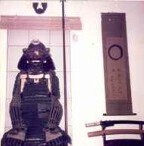
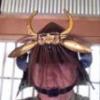



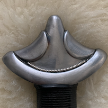

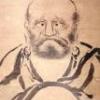

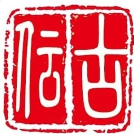













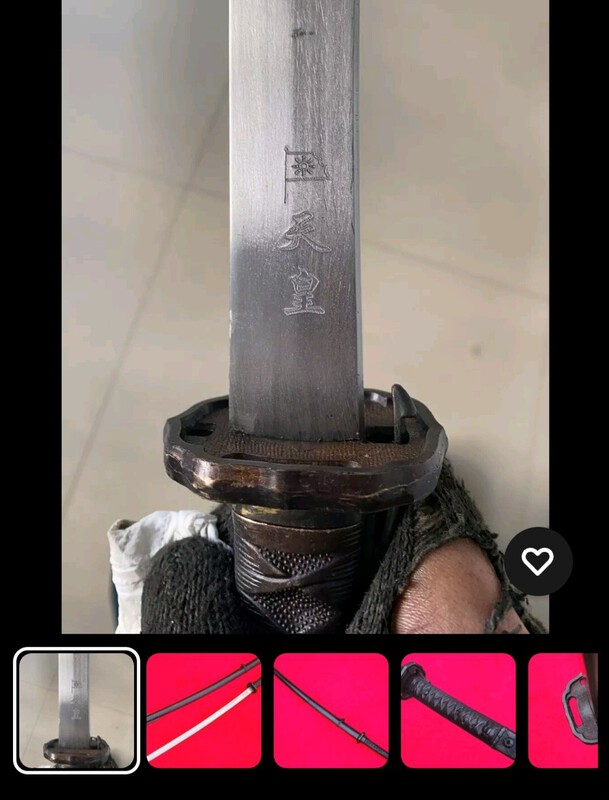


.thumb.png.9547b23064d3b1f42673d452d7dd1ca7.png)
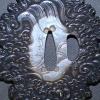



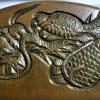










.thumb.png.54593db2789c8a1dcb235543b184ce39.png)
